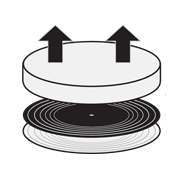Now Playing
Current DJ: The Panda
Maribou State All I Need (featuring Andreya Triana) from Hallucinating Love (Ninja Tune) Add to Collection
Requests? 773-DJ-SONGS or .(JavaScript must be enabled to view this email address)
 Before we start, I must admit that capturing live sound into the grooves of a durable plastic disc that can withstand thousands of playbacks is still a mind-blowing concept to me.
Before we start, I must admit that capturing live sound into the grooves of a durable plastic disc that can withstand thousands of playbacks is still a mind-blowing concept to me.
Over the years, I’ve participated in virtually every aspect of this process, from recording live sessions, to running a record label, organizing and archiving masters, and of course collecting records, yet the details of this process still amaze me.
This short article is meant to shed some light on the mechanics of this transformative process and help illuminate the way that songs find a new home in the bumps and folds of melted and pressed shards of vinyl shrapnel.
Let’s assume that we are starting off with a set of songs that have already been recorded and mixed to the band’s liking, which is the prerequisite for producing any type of physical recording. The next step is the crucial path diverting in the woods for all that is to follow — mastering.
Mastering for vinyl can be very different from mastering for compact discs, cassettes or downloaded output. The artist’s mixed audio is closely analyzed by a mastering engineer via sophisticated audio monitors. He or she makes decisions about how to tweak the audio with the unique specifics of the vinyl format in mind. The engineer will often employ corrective equalization and limiting to optimize the sound of the final vinyl’s fidelity, clarity and overall volume.
After the tracks have been mastered for sound, they are played through a lathe, a device which translates the sound to mechanical motion by cutting a precise continuous groove into a lacquer coated aluminum disc. The cutting engineer views the groove as it’s being cut through an attached microscope, allowing him or her to screen for any potential sound issues due to bass response, overloaded high end or overall audio length per side.
A separate disc is produced for each side of the final record. Each master disc is then coated with a thin coating of silver nitrate. The plate is then electroplated with an even thinner layer of nickel. When the metal is removed from the master, this metal disc has raised ridges where there were grooves on the master. The resulting plate is now called “the stamper.” These stampers are good for years and can accurately supply quality results for many re-pressings.
The vinyl pressing plant then loads up the stampers into a hydraulic press that uses hot steam to rapidly heat the vinyl sandwich about to be created. Vinyl chips are heated and pressed into individual hockey puck-sized portions called “biscuits.” At this point, the inner paper labels are pressed against the biscuits and held in place by suction cups. The searing hot stampers apply pressure to the vinyl biscuit and mold it into the record. Connecting pipes carrying cold water quickly harden the shaped vinyl platters and help finish bonding the labels to the platters’ surfaces.
After the pressing is complete, the discs are traced around the edges with a blade to clear all residual, uneven vinyl scraps. The records are allowed to cool and harden, then are slipped into paper sleeves before shipping to the record label and onto your friendly neighborhood record stores!
Next entry: Friday iPod/MP3 Shuffle—Happy Birthday Kate Pierson Edition
Previous entry: Friday iPod/MP3 Shuffle—Happy Birthday Lionel Hampton Edition